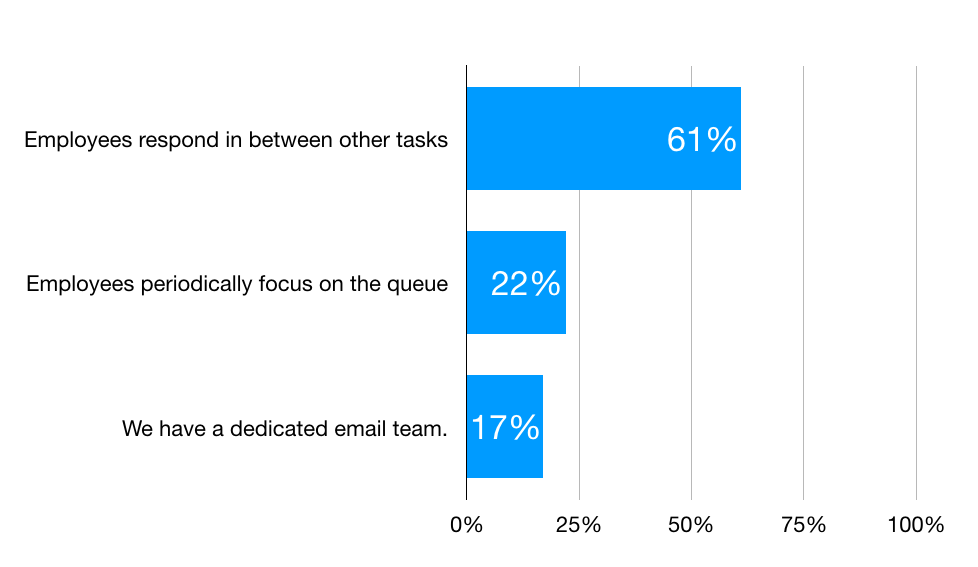Responding to customer email is a vexing challenge.
Many companies I know struggle to keep up with the volume. It can be difficult to balance customer demands for fast responses while handling other channels at the same time. Emails often require additional research before responding, which also takes extra time.
I recently partnered with customer service writing expert Leslie O'Flahavan to facilitate a webinar on meeting customer demands for speed while still sounding like a human. We kicked off the webinar with an audience poll that revealed a simple solution for many companies to respond both faster and better.
You can watch the webinar replay here or keep reading below to see the solution.
The Revealing Data
We asked webinar participants how they currently manage customer email. Notice that 61 percent have agents respond to email in between other tasks.
This typically happens in between phone calls. There are frequently lulls in between calls during an agent's shift. That's because phone calls tend to come in waves with peaks and valleys rather than a nice, steady stream. So all agents may be busy one moment and then things quiet down a few moments later.
That downtime in between calls can feel like waste if the agent isn't doing anything, so contact centers often give agents tasks to do while they're waiting for the next call.
Email seems like a natural fit for this sort of work. It fulfills a real need, but isn't time-sensitive like an incoming phone call. So the theory is an agent can work on email until the next call comes in and then put the email aside while they take the call.
This is actually a hidden problem.
The Hidden Problem
It may be easiest to highlight the problem with a little brain teaser designed by Shane Frederick. Read the problem below try to quickly think about your intuitive answer.
A bat and a ball cost $1.10 in total. The bat costs $1.00 more than the ball. How much does the ball cost?
The answer is below, but think about your response for a moment. Most people instinctively get this problem wrong because we aren't always good at perceiving the answers to mildly tricky challenges at first glance.
If you guessed the answer is $.10, you'd be like most people, though that's not the correct answer.
The answer is $.05. If the bat and ball cost $1.10 total and the bat costs $1.00 more than the ball, then $.05 (ball) plus $1.05 (bat) = $1.10.
Now, think of this same challenge in a customer service context.
Customers are notoriously poor at telling their story. So when an agent is reading emails in between calls, they are trying to quickly and intuitively grasp the meaning of a poorly written story before the next call comes in.
Here's an example that Leslie shared in the webinar. Try reading it quickly and intuitively think about what the customer wants.
The answer is much easier to find when you take your time. In this case, the customer wants to be sure his online order gets completed.
Now imagine a customer service agent reading this in a hurry. They may be tempted to zero in on the error messages the customer described. Or they may just find the whole thing confusing and have to re-read the email several times.
What we're really doing when we ask agents to respond to emails in between phone calls is asking agents to split their attention between two important tasks. Time and time again, I've seen this result in more errors and less productivity.
The Simple Solution
You can quickly solve this problem by giving your agents time to focus exclusively on emails.
The way many contact centers do this is by assigning agents to either a phone or email queue. Agents are then moved from one queue to the other as volume demands it.
For example, if phone volume suddenly spikes, agents can be moved from the email queue to the phone queue to help with the additional volume. Then, as volume subsides, some agents can be moved back to the email queue.
When one client experimented with this they noticed quality and productivity gains in both email and phone!
That's because agents assigned to the email queue could really focus. They grasped the customers' needs much faster and were able to get into the rhythm of writing fast and helpful responses. This also ensured agents were able to solve customers' issue on the first email far more often.
The phone agents were also kept busier because there were fewer people sitting around waiting for the next call. And when calls did come in, they found themselves focused and ready rather than needing a second to mentally transition from an email they were writing.
Of course, you don't need to take my word for it! Conduct an experiment and try it out for yourself over a two week period. Note any changes to agent productivity, contact quality, and even agent morale.




